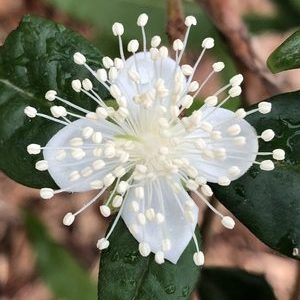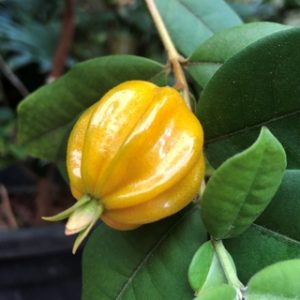Eugenia selloi (neonitida)
Pitangatuba, pitangola
Origin
The cerrado and Atlantic forest regions of Brazil.
Climate
It is adapted to low-lying sub-tropical and tropical open areas with drier conditions than experienced in more western Brazilian forests.
Plant Description
A small perennial evergreen bush growing to 2.5m with spreading branches. The opposite leathery entire leaves, 3-5cm long on a short petiole and containing oil glands, are glabrous dark green on the upper surface and finely pubescent lighter colour underneath.
Relatives
Pitangatuba is in the large Myrtaceae family that has >140 genera and >5000 species, with nearly 1000 species in the genus Eugenia. Other fruiting relatives in the family include grumichama, rose apple, pitanga, feijoa, jaboticaba and cherry guava.
Soils
They’re found on sandy, acidic nutrient-poor soils in Brazil.
Propagation
By seeds which are recalcitrant and slow in germinating.
Cultivars
There are no established cultivars.
Flowering and Pollination
The single white axillary hermaphrodite tetramerous sweet-smelling flowers, 2-3cm wide, have numerous stamens (>100), white anthers and an inferior ovary with a small stigma; as leaves are opposite there can be 2 flowers per node. Flowering occurs from October to November in Brazilian regions at 20-25° latitude, with anthesis beginning at dawn each day and receptivity lasting up to 2 days. Individual plants are self-incompatible, so either grafting different genetic scions or separate plants are needed for successful fertilisation and fruit being carried through to maturity. Fruit set is only 15-20% with open pollination; this is not a result of inadequate pollination as there is no increase with cross hand-pollination. Although flowers have many insect visitors, bees are the main pollinators; there are no nectaries, so only pollen is available to them.
Cultivation
Not known, but from its native habitat it would seem not to be a nutrient hungry species.
Wind Tolerance
As a small bush this should not be a problem.
Pruning
Standard practice of opening up the foliage to ensure sufficient light penetration throughout the plant would be a good strategy.
The Fruit
The indehiscent oblong fruit is a 6-9 ribbed berry, 3-6 X 2-3cm and weight 6-9g, with a thin green skin that turns bright yellow when ripe. There is a thick and fleshy pulp with a bitter sweet taste and a pleasant aroma, usually containing one, more rarely two seeds, 1-2 X 1cm, that separate easily.
Fruit Production and Harvesting
Fruit are produced from November to January in native areas of Brazil, so probably a little later in the Perth region. Seedlings have a short juvenility period.
Fruit Uses
Fruit are eaten fresh or processed in some way eg juices and jellies.
Pests and Diseases
Beetle larvae can grow inside fruit and seeds.
Comments
As there’s been little research done on this species in its native environment and none in WA, the best we can do is adopt management practices comparable to better known south American relatives in the genus eg pitanga. To obtain fruit, self-incompatibility will need to be addressed with multiple plants or grafts. It would be quite suitable as a pot plant given its small size.

